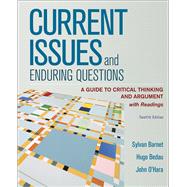Current Issues and Enduring Questions is a text and reader that serves as an extensive resource for teaching argument, persuasive writing, critical thinking, and research. It includes readings on topics that matter to students, such as being seen as “the other” and student loan forgiveness, issues that students will want to engage with and debate. Comprehensive coverage of classic and contemporary approaches to argument includes Aristotelian, Toulmin, Rogerian, and a range of alternative views, such as analyzing and writing about visual arguments.
This new edition does more than ever to make argument concepts clear, and to give students strategies for crafting effective arguments. For today’s ever-increasingly visual learners who are challenged to separate what’s real from what’s not, new activities and visual flowcharts support information literacy. Newly annotated readings highlight important rhetorical moves. And new readings explore controversial issues such as mass incarceration, cultural appropriation, and the way computer algorithms make biased decisions.








